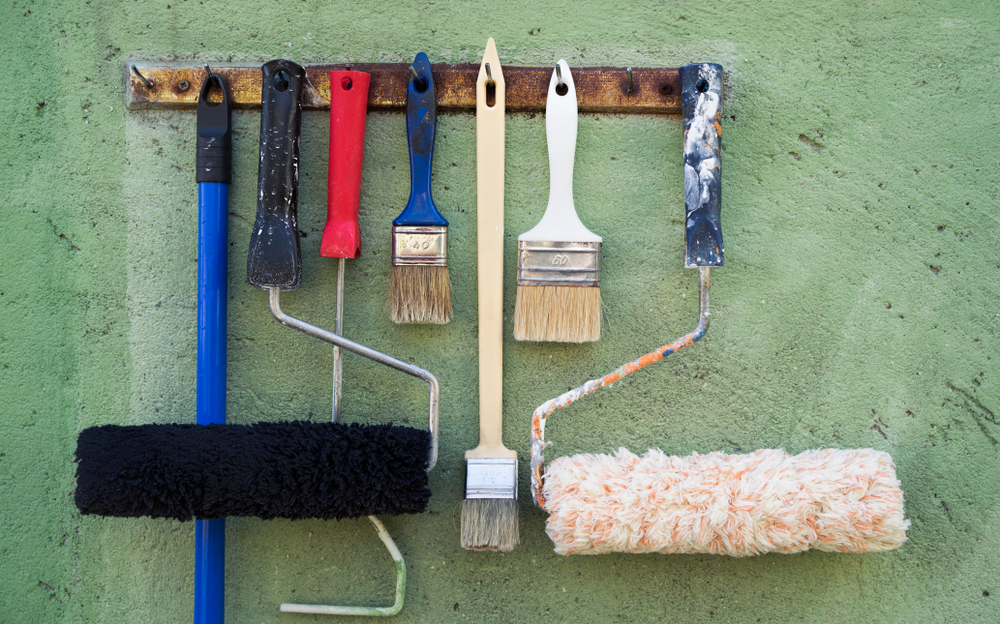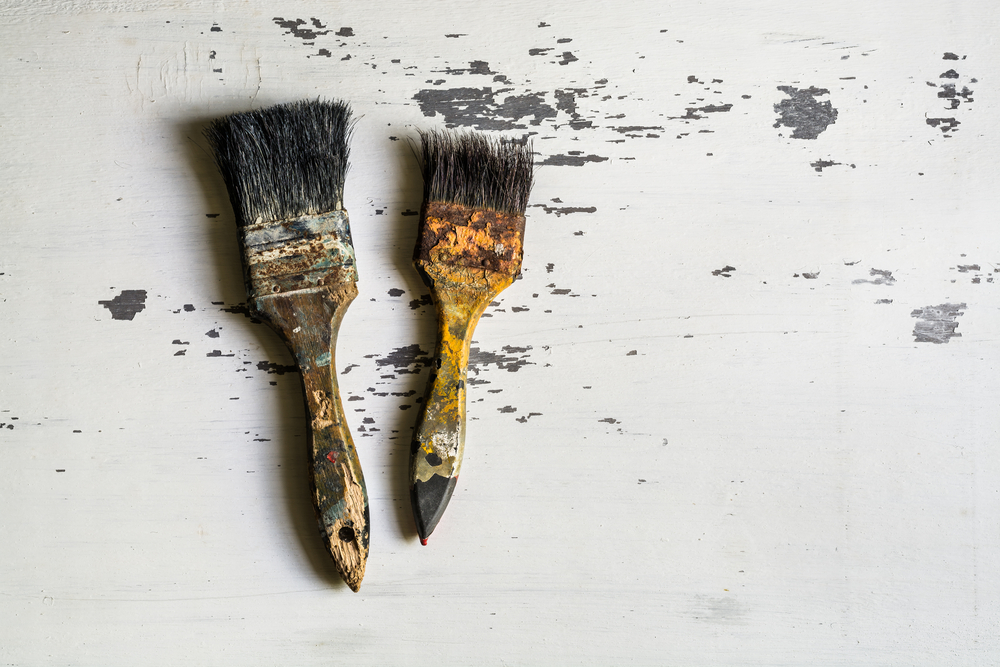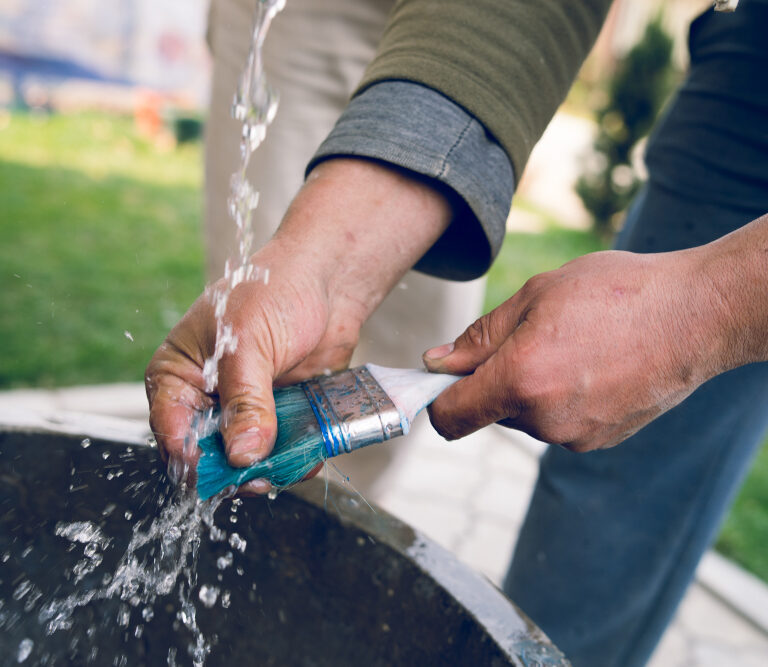Been painting a fence? Or a wall? Or your face?
If you’ve been left with mucky brushes and you’re not sure how to clean them, we’re here to help. We’ve brought you hacks, tips, and step-by-step guides —here’s how to clean your paint brushes, no matter what state they’re in.
- Types of Paint Brushes and Types of Paint
- What Equipment Do I Need to Clean Paint Brushes?
- How to Clean Water-Based Paint and Latex Paint From Paint Brushes: A Step-by-Step Guide
- How to Clean Oil Paint From Paint Brushes: A Step-by-Step Guide
- How to Clean Shellac Paint From Paint Brushes
- Why It’s Important to Clean Paint Brushes Properly and Promptly
- Where Should I Store Clean Brushes?
- How Do I Clean a Brush With Dried-On Paint?
- Top Tips for Cleaning Paint Brushes
- A (Paint) Job Well Done
Types of Paint Brushes and Types of Paint
Before we get to the all-exciting cleaning part, let’s take a detour first through the murky world of paint and paintbrushes.
Generally, there are three different types of brushes: nylon, polyester, and animal hair. And there are three general types of paints: latex (which are also known as water-based paints), oil, and shellac.
You should use nylon and polyester brushes for painting with latex paints, while you can use any type of brush for both oil and shellac paints. If you use a natural hair brush for a latex paint, the bristles will eventually swell and become weak and misshapen.
A sidenote here: you should always buy good-quality paint brushes. The better the brushes, the better the job they’ll do, the longer they’ll last, and the easier they’ll be to clean. If you only have subpar brushes, buy some new ones. Here are some of our favorites.
What Equipment Do I Need to Clean Paint Brushes?
Different types of paints (and different types of brushes) require different equipment, but here’s a big old list of everything you might need:
- Gloves: for cleaning some paints, you’ll be using chemicals which can harm and burn your hands. And even if you’re not, cleaning brushes is a dirty job.
- Bucket: no-one ever got much cleaning done without a bucket.
- Brush comb: for getting into the places that nothing else can get into. Brush combs are an excellent tool for giving your brushes a proper clean. You’ll be surprised by just how much hidden paint they dig out.
- Newspaper: for wiping and drying. Or reading, if you get bored.
- Water
- Soap
- A rag or cloth, for drying
- Denatured alcohol
- Paint thinner
- Lacquer thinner
- Household ammonia
- … last of all, you’re gonna need those dirty brushes. But you probably worked that out for yourself.
Again, as mentioned, different types of brushes and paints require different types of clean-up jobs, so make sure you’ve checked the guides below to see which of these pieces of equipment you’ll need (depending on the type of paint you’re washing off your brushes).
Assuming you’ve just finished a paint job and got all your equipment ready, here’s how to clean a paint brush:
How to Clean Water-Based Paint and Latex Paint From Paint Brushes: A Step-by-Step Guide
Step 1.
First up, wipe off all of that excess paint. Use the side of the can, or a newspaper, or a rag, whatever works best. But squeeze off as much of the excess paint as you can. When you think you’ve squeezed it all off, try again. Use your fingers, don’t be shy.
Step 2.
Next, give the brush a good wash in a bucket full of soapy water. Again, get your hands dirty by scrubbing through the bristles with your fingers, to make sure there are no big chunks of paint secretly lurking in the bristles.
Step 3.
Use that brush comb. Then give your brush another wash in that soapy water.
Step 4.
You then need to rinse your brush under a faucet, to make sure all of the soap is washed out. The faucet might even knock out some more chunks of lodged paint. When you’re done, dry your brush, through a combo of shaking it and using your rag/towel/whatever.
How to Clean Oil Paint From Paint Brushes: A Step-by-Step Guide
Step 1.
Again, wipe off the excess paint before you do anything else. Just like in the last step, it’s important to get off as much excess paint as you can before you start cleaning up properly.
Step 2.
Rinse your brush thoroughly in paint thinner. Make sure you’re wearing those protective gloves. While you’re doing this step, use that brush comb.
Step 3.
Dry the brush with a rag, making sure you’re removing as much paint (and paint thinner) as you possibly can.
Step 4.
Repeat stages 2 and 3, just to make sure you’re eliminating all the paint you possibly can. And use that brush comb again.
Step 5.
Dip your brush into lacquer thinner, before then drying again.
Step 6.
At this point, you can clean your brush in clean, soapy water. If you’re using a natural hair brush, you might want to skip this step, as water can damage natural hair brushes by making the bristles all swollen.
How to Clean Shellac Paint From Paint Brushes
This one’s pretty simple. You follow the steps for the oil-based paint cleanup, but with one difference —whenever you would use paint thinner in the above section, simply use an ammonia solution, or denatured alcohol instead. Easy.
Why It’s Important to Clean Paint Brushes Properly and Promptly
If you don’t clean your paint brushes properly, they’ll wind up damaged and clumpy, and the bristles won’t work as they should. Then you’ll need to replace them, and you’ll end up spending unnecessary cash on endless packs of brushes. So, although it’s annoying, you should always try to clean your brushes regularly —and clean them as soon as you’ve finished using them.
It’s way easier to clean brushes as soon as you’ve used them (before the paint has dried on), so you should always try to wash your brushes the moment you’ve finished painting with them. Sorry for being your mom.
Where Should I Store Clean Brushes?

If you want your brushes to retain their shape, consider wrapping them in paper, before tying that paper with string. This will help your brushes to stay in shape, and will stop air and humidity from affecting them too much. If that’s your plan, wrap your brushes as soon as they’re clean and dry.
Store them in a cool, dry place, like a garage or a tool shed.
How Do I Clean a Brush With Dried-On Paint?

If you’ve been lazy and waited too long to clean your brush, it’s likely turned into an intimidating cocktail of clumpy paint and stiff bristles. Brushes with dried-on paint are known as “petrified brushes.” Weird, right? But if you are petrified of yours, you don’t need to be – you can absolutely still clean a brush with dried-on paint. And it’s probably easier than you imagine.
The first thing you need to do is soak the brush for 24 hours (or even 48 hours if the paint is particularly obstinate). You can soak it in vinegar, paint stripper or soapy water (but don’t use water for a natural hair brush). While the brush is soaking, keep it flat or propped up —if the brush bristles stay bent out of shape during this soaking period, they’ll wind up damaged.
After the 24 (or 48) hours, you’ll probably find that the brush is no longer stiff or caked with paint. If that’s the case, you can now comb the chunks out with your comb, before washing the brush by following the steps we’ve already outlined above. And it’ll be good as new!
If none of that works, try an industrial-style brush cleaner.
Top Tips for Cleaning Paint Brushes
Ravenous for more brush-cleaning knowledge? Here are some of our favorite top tips:
- If you’re ever unsure on how to clean a particular brush, which brushes you should use, what type of paint you should use with which brushes, or whatever else, go to your local hardware store. That’s always the best place to get bespoke advice.
- Always always, always, clean your brushes outside. It’s a messy job. And some of the stuff you might be using (such as lacquer thinner) is ridiculously flammable. You don’t want to set your house on fire in pursuit of a clean paint brush.
- When storing your brushes, either hang them up or lay them flat. If you stuff them into a bag or box, you’ll ruin the bristles. If you’ve gone to all this effort to clean your brushes properly, it’s worth storing them properly.
- If you do a lot of painting and you’re tired of never getting your brushes properly dry or fully clean, consider using a paint brush spinner. Paint brush spinners swivel around swiftly to get your brushes as clean and dry as possible. Here’s one in action.
A (Paint) Job Well Done
Well, there you have it, all you ever needed to know about how to clean your paint brushes. Now you can confidently undertake all those paint jobs you’ve been meaning to do without having to worry about ruining your brushes. With the right equipment and the appropriate care, you’ll extend their lifetime tremendously.
